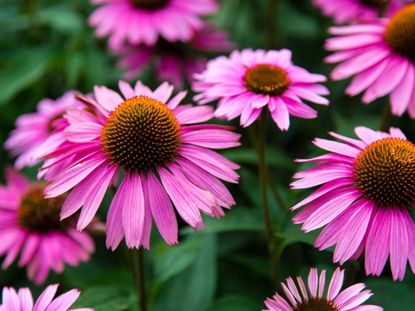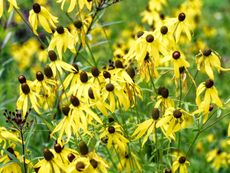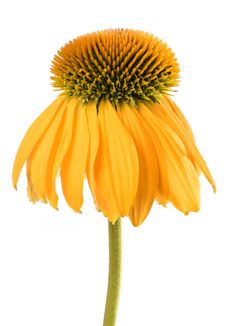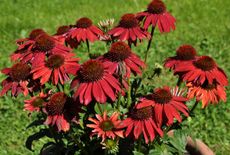Purple Coneflower Plants: Information On Growing Purple Coneflowers


A native to the eastern United States, purple coneflowers are found in many flower gardens. Planting purple coneflower (Echinacea purpurea) in the garden or flower bed draws bees and butterflies, ensuring that nearby plants have plenty of pollinators.
The plant also provides a tall background or repeating rows of large, often 6 inches (15 cm.) across, purple, daisy-like flowers. The sturdy stalks, which may reach 5 feet (1.5 m.) in height, rarely bend or require staking for an upright appearance. Coneflower plants may actually display pink flowers, when the cultivar Echinacea purpurea ‘Pink Double Delight' is planted.
Growing Purple Coneflowers
Purple coneflower plants grow best in poor or lean soil. Rich or heavily amended soil may result in lush foliage and poor flowering. When planting purple coneflower, locate them in a full sun area.
Full sun is defined as at least six hours of sun each day. In more southern areas, morning sun may facilitate the best performance, with late afternoon shade protecting the plants from burning. Purple coneflower plants may be started from seed or root division:
- Seeds: If you wish to collect seeds for next year's crop of purple coneflower plants, do so before the birds have eaten all the seeds. Place a brown paper bag over the seed head, turn right side up, and let seeds drop into the bag. Professional growers believe stratification (chilling) of the seeds for a few weeks, after they are planted in moist soil, produces a more abundant bloom when growing purple coneflowers. Those in areas where temperatures remain warm year long may want to try this technique. Alternately, planting purple coneflower seeds in autumn, in areas with cold winters, allows the seeds to chill naturally.
- Division: Purple coneflower plants may be started from root division in fall. Only plants that have been in the ground for three years or longer should be divided. Younger coneflower plants may not have developed a root system that is extensive enough for division. Root division should be limited to every three to four years.
Growing purple coneflower from seeds is easy enough for the beginning gardener, while long-time gardeners delight in the ease of how to care for coneflowers.
How to Care for Coneflowers
Once planted and established, learning how to care for coneflowers is easy. In seasons with normal rainfall, additional watering is not necessary. Purple coneflower plants are drought resistant and often thrive in dry summers. Coneflower care may include limited fertilization, but this is often not needed.
If flowers are small or poorly developed, try working in a small amount of well composted material in the soil around the plants. When late summer blooms of the purple coneflower begin to look tired or ragged, cut the plant back by a third. This rejuvenates the plant and often produces a new display of beautiful blooms that last until frost. Coneflower care is as simple as that and the plants will reward you with abundant flowering each and every year thereafter.
Gardening tips, videos, info and more delivered right to your inbox!
Sign up for the Gardening Know How newsletter today and receive a free download of our DIY eBook "Bring Your Garden Indoors: 13 DIY Projects For Fall And Winter".

Becca Badgett was a regular contributor to Gardening Know How for ten years. Co-author of the book How to Grow an EMERGENCY Garden, Becca specializes in succulent and cactus gardening.
-
 Elegant Exotics: 8 Beautiful Amaryllis Varieties That Will Brighten Any Holiday Display
Elegant Exotics: 8 Beautiful Amaryllis Varieties That Will Brighten Any Holiday DisplayWhether red, pink, white or variegated, the right amaryllis varieties can enhance any living space, especially during the holidays. We round up eight of the most exquisite
By Bonnie L. Grant
-
 Forage For Herbs: 7 Tasty And Safe Wild Herbs To Pick Close To Your Own Backyard
Forage For Herbs: 7 Tasty And Safe Wild Herbs To Pick Close To Your Own BackyardIn addition to growing your own herbal staples, did you know there are several wild options out there that are safe and tasty – and free? Try foraging these 7 wild herbs
By Amy Grant
-
 How To Harvest Echinacea Flowers, Seeds And Roots
How To Harvest Echinacea Flowers, Seeds And RootsThe entire echinacea plant can be harvested and used for medicine and health. Learn here how to harvest your pretty coneflowers, from seeds to roots.
By Mary Ellen Ellis
-
 Growing Cutleaf Coneflower - Is Cutleaf Coneflower A Weed
Growing Cutleaf Coneflower - Is Cutleaf Coneflower A WeedCutleaf coneflower is a native wildflower, but that doesn't stop some from finding it weedy. Click here for more information.
By Mary Ellen Ellis
-
 What Is A Gray Headed Coneflower Plant - Care For Gray Headed Coneflowers
What Is A Gray Headed Coneflower Plant - Care For Gray Headed ConeflowersThe gray headed coneflower plant goes by many names and is a native wildflower. Click here for more information on this perennial plant.
By Mary Ellen Ellis
-
 Yellow Echinacea Care – Learn About Growing Yellow Coneflowers
Yellow Echinacea Care – Learn About Growing Yellow ConeflowersEchinacea paradoxa stands out from other native echinacea plants. The “paradox” indicated in this variety’s name comes from the fact that it is the only native echinacea to produce yellow petals. Learn about growing yellow coneflowers here.
By Darcy Larum
-
 Coneflower Herbal Uses – Growing Echinacea Plants As Herbs
Coneflower Herbal Uses – Growing Echinacea Plants As HerbsConeflowers are pretty plants with big, bright flowers that attract butterflies and songbirds to the garden. But people have also been using coneflowers medicinally for many, many years. Click this article for more information on coneflower herbal uses.
By Teo Spengler
-
 Types Of Coneflower – Learn About Different Kinds Of Coneflower Plant
Types Of Coneflower – Learn About Different Kinds Of Coneflower PlantBy Mary Ellen Ellis
-
 Coneflowers In A Pot – Tips On Caring For Container Grown Coneflowers
Coneflowers In A Pot – Tips On Caring For Container Grown ConeflowersConeflowers are very popular, colorful, flowering perennials. But what about containers? If you don't have the space for a garden bed, will coneflowers grow just as well on a patio or balcony? Click this article to learn more about how to grow coneflowers in a pot.
By Liz Baessler
-
 Echinacea Deadheading: Do You Need To Deadhead Coneflowers
Echinacea Deadheading: Do You Need To Deadhead ConeflowersAlso known as purple coneflower, Echinacea has grown wildly and contently for hundreds of years without any maintenance. When I suggest coneflowers to a customer, I am often asked "do you need to deadhead coneflowers?" Click here for the answer.
By Darcy Larum